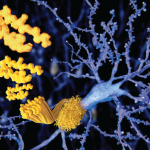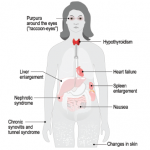But the results were dramatic. Disease progression was measured by the Neurologic Impairment Score plus 7 nerve tests (NIS + 7), a 270-point scale, a comprehensive instrument combining clinical assessment, EMG measures, and computer-directed sensory testing. The score increased by 25 in the placebo group vs. only 8.7 points in the diflunisal group (p<.001). This makes a big difference functionally, according to Dr. Berk.
“What does that mean? It’s the strength to get out of a chair,” he said. “If you don’t think that’s significant, when you have neuropathy and can’t get out of a chair or off the toilet, you’ll feel differently.”
Overall, there is good cause for optimism in amyloidosis treatment.
TTR stabilization, he said, “definitely works.”
“Diflunisal inhibits neurologic disease dramatically,” he said. “Almost a third of the people taking diflunisal for two years had no change in their NIS score, no neurologic progression. It preserves or improves quality of life. It’s effective across mutations, gender, severity of disease and it gives new life to an obsolete drug.”
Tamafadis
Another agent, tamafadis, studied just before the diflunisal, also stabilizes the tetramer. It doesn’t come with the toxicity concerns of an anti-inflammatory, but is more costly. In a trial, it showed an effect but didn’t meet its primary endpoint. It has been approved in Europe, though not in the U.S.
Other Therapies
According to Dr. Berk, despite the successes, most patients on TTR stabilizing agents—about 70%—still progress slowly. So there’s a need for better therapy. Two companies—Alnylam and Ionis—have been working on TTR gene-silencing therapies. Both drugs have been found to suppress TTR protein production, diminishing circulating TTR dramatically.
In a phase II trial presented in November at the European Congress on Hereditary ATTR, in which Dr. Berk was an investigator, Alnylam’s agent was found to bring about sustained, 80% suppression of TTR levels.2 A randomized, Phase 3 trial to assess effects on neurologic deficits is now underway.
The latest therapeutic efforts in amyloidosis involve deploying antibodies to knock out a building block of amyloid in the hope that this will lead to the elimination of the deposits. The approach, described recently in the New England Journal of Medicine, involves treating patients with systemic amyloidosis with an agent known to clear serum amyloid P from the plasma, then using antibodies to target SAP in the deposits themselves.3 So far, Phase 1 results show that the approach can safely clear amyloid from the liver and some other tissues.


